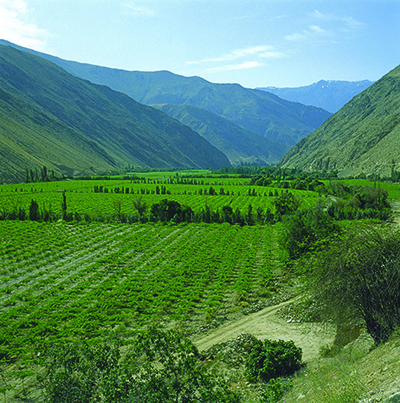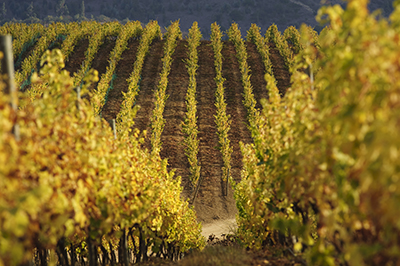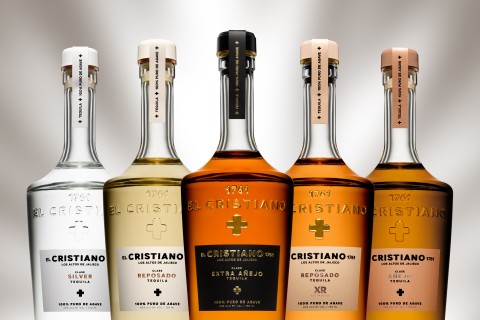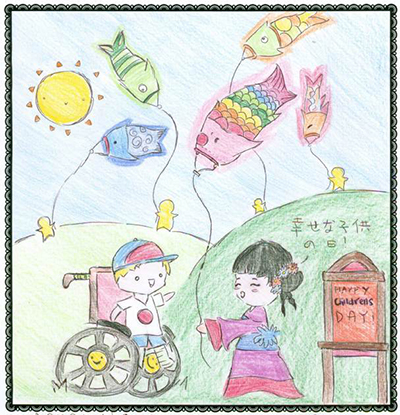 After decades of successfully exporting good quality entry level wines, Chile has emerged as an important producer of premium wines. In cool climate coastal regions such as Casablanca, San Antonio, Elquí, and Limarí, several wineries are crafting crisp and mineral-rich Sauvignon Blanc and elegant Pinot Noir. In the more temperate regions of Maipo, Aconcagua, Colchagua and Cochapoal, they are turning out richly flavored Carmenere and fruit-forward red blends. And in the South of Chile in the Bio-Bio, Malleco and the Maule Valley, wineries are proving they can produce distinctive Pinot Noir, Chardonnay and terroir-driven Carignan. Indeed, the emergence of premium quality Carignan in the hot dry Maule region is proving to be an exciting success story of the Chilean Wine Revolution.
After decades of successfully exporting good quality entry level wines, Chile has emerged as an important producer of premium wines. In cool climate coastal regions such as Casablanca, San Antonio, Elquí, and Limarí, several wineries are crafting crisp and mineral-rich Sauvignon Blanc and elegant Pinot Noir. In the more temperate regions of Maipo, Aconcagua, Colchagua and Cochapoal, they are turning out richly flavored Carmenere and fruit-forward red blends. And in the South of Chile in the Bio-Bio, Malleco and the Maule Valley, wineries are proving they can produce distinctive Pinot Noir, Chardonnay and terroir-driven Carignan. Indeed, the emergence of premium quality Carignan in the hot dry Maule region is proving to be an exciting success story of the Chilean Wine Revolution.
Carignan is not new to Chile. It has been grown in the Maule Valley for more than 70 years. First planted on a large scale in the early 1940s, it served as a work horse grape for blending. The grape’s high acidity, color and flavor were all seen as helpful additives to improve the local wines. Carignan is a rustic grape originally grown in the Mediterranean regions of France (Languedoc) and Spain (Priorat). It exhibits good acidity, ripens late in the season and grows well in the hot dry Maule Valley where mildew is not a problem.
Although this workhorse variety was primarily used for blending, Chilean winemakers have recently come to realize that their head-pruned, old vine Carignan can produce exciting wines. Most of Chile’s old vineyards are 30+ years old, dry farmed and hand-harvested. The wines come in a variety of styles. Some wines exhibit pure red berry fruit and toasted oak while others tend towards darker red plum, mulberry and black fruit. While most are aged in French and American oak, others are produced with little or no oak and reveal considerable earthiness and terroir.
Vigno “Vignadores de Carignan” is an organization of growers and winemakers for the marketing and promotion of Carignan of the Maule Valley. It was established in November 2009 by 12 founding wineries, representing a mix of small and medium-sized producers. They are: Bravado Wines, De Martino, Garage Wine Co, Viña Gillmore, Viña Lomas de Cauquenes, Viña Meli, Miguel Torres, Morandé, Odfjell, Undurraga, and Valdivieso. Vigno wines must be made from at least 65% old, dry-farmed Carignan vines from Maule. The vines have to be dry-farmed and head pruned bush vines (gobelet). Vigno has helped put Chilean Carignan on the map and is dedicated to preserving the vineyards and promoting the quality of Carignan worldwide.
The area of San Antonio was once primarily a shipping port known for its seafood, not produce, but in recent years, the valley has made itself known as one of Chile’s most expressive cool climate wine regions. Until 1998, it was believed that there was no available water source for irrigation. However, once a source was discovered in the Leyda sector of San Antonio, there was no looking back. The valley’s first vintage wine, a Pinot Noir, was released in 2001 and the area was officially named a quality wine region just ten years ago in 2002. San Antonio Valley is further divided into sectors Leyda, Lo Abarca, Rosario, Malvilla, Cartegena, and Lleoleo. Of these Leyda is the best known, largely due to the source of irrigation, and its name has become almost synonymous with San Antonio.
Its proximity to the ocean and thin, rocky soils comprised of decomposed granite and red clay offer perfect growing conditions for Chardonnay, Sauvignon Blanc, and Pinot Noir, and more recently Syrah. San Antonio also grows small plantings of Riesling and Gewurztraminer which are not common in the rest of Chile, but show great potential in this area.
San Antonio has the coolest climate of all the coastal regions in Chile and has several plantings within site of the ocean at just 5km inland. This contributes to the region’s signature style of crisp, mineral driven white wines and concentrated red wines both of which boast high levels of acidity and strong aromatic components. Unfortunately, this does not come without risk. Because of San Antonio’s proximity to the ocean, the area is known for high winds, fog, and humidity. As a result, the area is more susceptible to frost and rot than other areas. Conversely, the wind, fog, and mist play an important part in keeping the grapes cool which is important for the development of the defining character found in the wines of San Antonio.
Within the San Antonio valley, there are four main wineries including Matetic, Casa Marin, Amaral, Leyda, and Amayna and two main vineyard sites for Leyda and Amayna wineries. These wineries are largely responsible for the production of some of Chile’s finest cool-climate varietal wines. However, many other wineries source fruit from the region and this is becoming increasingly popular.
Despite the fact the valley’s winemaking culture is still largely in its infancy, the wines of San Antonio Valley have captured the hearts and palates of even the toughest wine critics. Their elegance and finesse for which the region’s top varieties are known are further enhanced by the influence of the unique terroir resulting in an expression that is distinctly Chilean.
Reaching far to the north of Chile are the Limari and Elqui Valleys whose climate, despite being so close to the equator, are classified as cool climate growing areas.
Limari Valley, though considered a generally new region, has a winemaking history dating back to the 16th century. What makes this a “new” region, however, is the innovation and technology combined with exploration of new microterroirs that have shed new light on the region’s potential.
The Limari Valley is greatly affected by the cooling morning fog that is caused by the Pacific Ocean which covers the area in the morning, but clears as the afternoon’s hot sun rises. The region is very dry – less than 4 inches of rain annually – but irrigation has made vine growing possible here. The lack of water, however, encourages the vines to dig deep into the soils and, in turn, there is a pronounced effect of minerality found in the wines. The variation in soils consisting of clay, silt, and chalk allow for expressive cool-climate wines such as Sauvignon Blanc and Syrah to flourish here. Limari is further divided into four areas Ovalle, Monte Patria, Punitaqui, and Rio Hurtado.
Stretching further to the north is the Elqui Valley located just south of the Atacama Dessert famed for being the driest desert in the world. Traditionally, the Elqui Valley was best known for the production of grapes to produce Pisco, but in recent years winegrowers have explored outer parts of the region such as along the coast and on the slopes of the Andes Mountains which are cooled by the winds from the Pacific Ocean. What they’ve found is that the region is ideal for planting cool-climate grapes such as Syrah and Cabernet Sauvignon. The region’s dry Pedro Ximenez wines have been shown great interest by exploratory sommeliers who are looking to push the boundaries. Within the Elqui Valley there are two sub-regions: Vicuna and Paiguano.
Like the Limari Valley, Eliqui’s rainfall is very low here at just 2.8 inches per year, but the rocky terrain allows vines to burrow deep into the clay, silt, and chalk soils for moisture and nutrients. Apart from wine production, Elqui is well-known for its clear skies and famed for the world-class observatories located there.
The exploration of new regions in Chile has allowed for the increasing production of cool-climate wines which offer lower alcohol and showcase more of the grapes’ and regions’ character. Despite both regions remaining relatively small in terms of wine production there has been increasing interest from wineries throughout the country; these Valleys are definitely two to watch.
About Wines of Chile
Wines of Chile is an organization committed to promoting the quality and image of Chilean wine throughout the world. It has offices in Santiago, London, and New York, as well as representatives in Canada, Ireland, and Denmark. WOC also works closely with ProChile to develop and offer promotional and educational programs in Asia, Latin America and Europe. Wines of Chile’s 92 member wineries belong to Vinos de Chile and represent 92% of Chile’s bottled wine exports. For more information please visit www.winesofchileusa.com and find them on Facebook, Youtube, and Twitter.










